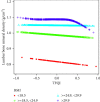Association between Sensitivity to Thyroid Hormone Indices and Bone Mineral Density in US Males
- PMID: 36340930
- PMCID: PMC9629943
- DOI: 10.1155/2022/2205616
Association between Sensitivity to Thyroid Hormone Indices and Bone Mineral Density in US Males
Abstract
Objectives: Thyroid hormone is acknowledged as a pivotal factor in skeletal development and adult bone maintenance. However, available data about the relationship between sensitivity to thyroid hormone and bone mineral density (BMD) remain limited and conflicting. The purpose of the study was to explore the complex relationship between sensitivity to thyroid hormone indices and BMD using cross-sectional analysis.
Methods: An overall sample of 3,107 males from the National Health and Nutrition Examination Survey (NHANES) was studied in the study. The thyroid hormone sensitivity indices included free triiodothyronine/tree thyroxine (FT3/FT4), thyroid-stimulating hormone index (TSHI), thyrotroph thyroxine resistance index (TT4RI), and thyroid feedback quantile-based index (TFQI). Given the complex study design and sample weights, the correlation between sensitivity to thyroid hormone indices and BMD was evaluated through multivariate linear regression models, and extra subgroup analyses were performed to examine the robustness of the results.
Results: Among the 3,107 participants, we demonstrated that FT3/FT4 was negatively correlated with lumbar BMD (β = -0.0.35, 95% CI: -0.084-0.013, P < 0.05). In the terms of central sensitivity to thyroid hormone, TFQI showed a significant negative relationship with the BMD of the lumbar (β = -0.018, 95% CI: -0.033 to -0.003, P < 0.05), total femur (β = -0.020, 95% CI: -0.035 to -0.006, P < 0.01), and femur neck (β = -0.018, 95% CI: -0.031 to -0.005, P < 0.01). In the subgroup analyses stratified by body mass index (BMI), the significant negative correlation between TFQI and lumbar BMD remained in the male participants with BMI between 18.5 and 24.9 kg/m2.
Conclusions: Decreased indices of sensitivity to thyroid hormones are strongly associated with increased lumbar BMD, suggesting that the dysfunction of peripheral and central response to thyroid hormone might contribute to bone loss. In addition, FT3/FT4 and TFQI were considered to be the preferable indicators to guide the prevention and clinical treatment of osteoporosis.
Copyright © 2022 Shuai Chen et al.
Conflict of interest statement
The authors declare that they have no conflicts of interest.
Figures




Similar articles
-
Association between sensitivity to thyroid hormone indices and the risk of osteoarthritis: an NHANES study.Eur J Med Res. 2022 Jul 11;27(1):114. doi: 10.1186/s40001-022-00749-1. Eur J Med Res. 2022. PMID: 35820977 Free PMC article.
-
Impaired sensitivity to thyroid hormone correlates to osteoporosis and fractures in euthyroid individuals.J Endocrinol Invest. 2023 Oct;46(10):2017-2029. doi: 10.1007/s40618-023-02035-1. Epub 2023 Feb 16. J Endocrinol Invest. 2023. PMID: 36795243
-
Impaired sensitivity to thyroid hormones is associated with increased body fat mass/muscle mass ratio (F/M) in the euthyroid population.Diabetol Metab Syndr. 2025 Apr 15;17(1):128. doi: 10.1186/s13098-025-01693-w. Diabetol Metab Syndr. 2025. PMID: 40234912 Free PMC article.
-
Association between serum vitamin D levels and sensitivity to thyroid hormone indices: a cross-sectional observational study in NHANES 2007-2012.Front Endocrinol (Lausanne). 2023 Sep 5;14:1243999. doi: 10.3389/fendo.2023.1243999. eCollection 2023. Front Endocrinol (Lausanne). 2023. PMID: 37745711 Free PMC article.
-
Effects of thyroid-stimulating hormone suppression after thyroidectomy for thyroid cancer on bone mineral density in postmenopausal women: a systematic review and meta-analysis.BMJ Open. 2021 May 13;11(5):e043007. doi: 10.1136/bmjopen-2020-043007. BMJ Open. 2021. PMID: 33986046 Free PMC article.
Cited by
-
Effects of perampanel on bone health in adult patients with epilepsy.Epilepsia Open. 2025 Jun;10(3):822-830. doi: 10.1002/epi4.70038. Epub 2025 Apr 7. Epilepsia Open. 2025. PMID: 40192489 Free PMC article.
-
Association between sensitivity to thyroid hormones and trabecular bone score in euthyroid individuals: a population-based cross-sectional study.BMC Musculoskelet Disord. 2024 Dec 20;25(1):1050. doi: 10.1186/s12891-024-08190-7. BMC Musculoskelet Disord. 2024. PMID: 39702097 Free PMC article.
-
Association between impaired sensitivity to thyroid hormones and sedentary behavior: a cross-sectional study.Front Med (Lausanne). 2025 Jun 6;12:1596669. doi: 10.3389/fmed.2025.1596669. eCollection 2025. Front Med (Lausanne). 2025. PMID: 40547924 Free PMC article.
-
Serum FT3/FT4, but not TSH is associated with handgrip strength in euthyroid U.S. population: evidence from NHANES.Front Endocrinol (Lausanne). 2024 Mar 4;15:1323026. doi: 10.3389/fendo.2024.1323026. eCollection 2024. Front Endocrinol (Lausanne). 2024. PMID: 38501102 Free PMC article.
-
Hyperthyroidism increases the risk of osteoarthritis in individuals aged 60-80 years.Sci Rep. 2024 Jun 17;14(1):13924. doi: 10.1038/s41598-024-64676-3. Sci Rep. 2024. PMID: 38886465 Free PMC article.
References
LinkOut - more resources
Full Text Sources

